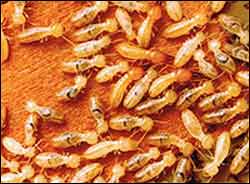Termites a major threat to Victoria

Subterranean termites pose a major threat to dwellings and other vital infrastructure throughout Victoria according to a report released today by CSIRO Forestry and Forest Products (CFFP) scientist, Jim Creffield.
Mr Creffield says that in order to effectively manage the pest, all municipalities state-wide must immediately be ’termite declared’.
The report draws upon the expertise of the CSIRO Termite Group – comprised of ensis (a recently formed joint venture of CFFP and Forest Research, New Zealand) and CSIRO Entomology.
The annual cost of repair of damage to timber-in-service caused by termites in Victoria has been estimated to be in excess of $200 million.
Of the state’s 78 municipalities, 30 are not currently designated as being at risk of termite infestation of homes and other private and public structures. “However, no municipality in metropolitan Melbourne, for example, is devoid of infestation by termites,” Mr Creffield says. He says redesignation of undeclared (unprotected) municipalities to ’declared’ status should be enacted through state legislation or individual council motion.
It is estimated that 650,000 Australian homes have been infested by termites over the last five years. The cost of treatment and repair of the resultant damage has been estimated at $3.9 billion. In undeclared areas, builders are not required to install termite management systems (TMS) during construction. “It is far more economical to have a TMS or barriers installed, than to incur damage and consequent restoration costs,” Mr Creffield says. “Normal building insurance does not cover damage caused by termites – it is the responsibility of the owners.”
Mr Creffield has over 30 years experience in the biology and control of termites and believes that regardless of the type of construction, without an adequate TMS termite infestation will almost certainly occur at some stage during the life of the structure.
A mature nest of termites can consist of over a million insects headed by a queen capable of laying up to 2000 eggs per day. Termites can feed on timber and timber products at up to 100m from their nests and can travel greater distances when provided with access to gaps, cracks, crevices or construction materials including pipes and cables. Termites will even attack electrical wiring cables, conduits and power points.
An infestation is often not detected until it is so severe that structural damage has occurred and substantial repairs and material replacement are required.
The full report can be viewed and downloaded from the CSIRO Forestry and Forest Products website at www.ffp.csiro.au or through Termite Action Victoria at www.termiteactionvictoria.com.au
Media Contact
All latest news from the category: Life Sciences and Chemistry
Articles and reports from the Life Sciences and chemistry area deal with applied and basic research into modern biology, chemistry and human medicine.
Valuable information can be found on a range of life sciences fields including bacteriology, biochemistry, bionics, bioinformatics, biophysics, biotechnology, genetics, geobotany, human biology, marine biology, microbiology, molecular biology, cellular biology, zoology, bioinorganic chemistry, microchemistry and environmental chemistry.
Newest articles

“Nanostitches” enable lighter and tougher composite materials
In research that may lead to next-generation airplanes and spacecraft, MIT engineers used carbon nanotubes to prevent cracking in multilayered composites. To save on fuel and reduce aircraft emissions, engineers…

Trash to treasure
Researchers turn metal waste into catalyst for hydrogen. Scientists have found a way to transform metal waste into a highly efficient catalyst to make hydrogen from water, a discovery that…

Real-time detection of infectious disease viruses
… by searching for molecular fingerprinting. A research team consisting of Professor Kyoung-Duck Park and Taeyoung Moon and Huitae Joo, PhD candidates, from the Department of Physics at Pohang University…





















